BUD BUSCHARDT, HE’S SUMP’N ELSE!
He’s “Sump’n Else!“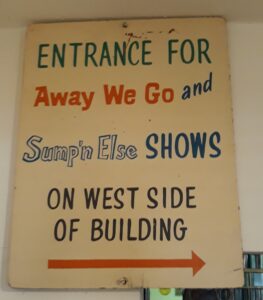
Bud Buschardt, Unit Manager of “Sump’n Else”, Producer/Director at WFAA, Oldies Show host at KVIL and Retired Adjunct Professor at UNT
Edited by Scott Mathews and Paul Heckmann, Executive Director, Memories Inc.
Paul Heckmann: Greetings my friend, so glad we were able to spend some time on this project. Bud, can you kinda tell me a little bit about where you are from and what got you interested in TV and Radio?
Bud Buschardt: You bet!
Like most of us I watched TV and I listened to radio all my life. I still remember listening to Uncle Phil and Aunt Jane on KXYZ when I was just a little guy. And when I was about 5 or 6 years old, my mother took me up to the radio station to see them.
So, I was watching the guy in the control room doing the announcing. They used to have places for you to sit in radio stations, and you could watch the shows as they were going on. That was my first experience in radio. Uncle Phil and Aunt Jane would play children’s story records like Jack and the Beanstalk.
Paul: Cool. And those experiences are the ones that stay with you all your life.
Where did you go to school at Bud?
Bud: I grew up in Houston, and I went to Lamar HS there, then the University of Houston, I’m a Houston Cougar.
Paul: Was your degree at U of H in radio and film?
Bud: Radio and television. I started out to be in architecture. Before school started I had gone to the school counselor, he said, “You don’t like math do you?” I said, “I hate math.” And he said, “And you want to be an architect? It’s nothing but math.”
The story goes that I had taken my tape recorder into a repair shop to have it fixed on my way out to the University of Houston. I happened to mention to the clerk that I was on my way to
U of H to see a counselor. And he said, “Well, I was a radio/TV major. I really enjoyed that.”
You see back in those days, you had to declare a major really before you went in, So, I am thinking radio/TV sounded kinda neat, and so that is what I told the counselor, he put me down for radio/TV.
Paul: So you could say it was happenstance; a chance encounter, at just the right shop, with just the right fella, whose specialty was repairing tape recorders, that started a half century career in radio and television.
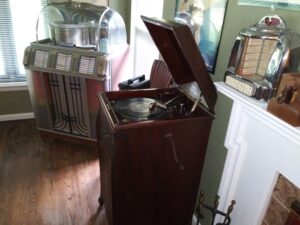
Part of Bud’s fabulous collection
Happenstance was the driving force.
Bud: Amazing, eh? But oh man, was it the right choice for me. I loved it. I really thought it was something.
After UH, my aunt invited me to come to Dallas when I couldn’t find a job in Houston. My uncle was a doctor and they had a brand new house on Beverly Drive. So after exhausting my options in Houston I packed up and headed to Dallas. My aunt and uncle had about five cars and only two people in the family drove, so they let me use a car. And my aunt, bless her heart, would make maps for me. She said, “Now go see Mr. Mac, he has friends at this station in Tyler. And on the way back you go over here to…”And she would kinda map out my course for the day when I was looking for jobs.
Paul: She sounds quite amazing.
Bud: Oh she was. One of those trips turned out to be pretty important. When I graduated in 1963, my mentor Dr. Tom Battin called me into his office and said, “If you ever get up to Dallas, go to WFAA. It is the most beautiful station, the most fabulous station in the whole State of Texas. Ask for Bob Turner.”
So here I am in Dallas, so I called and made an appointment with Mr. Turner who had just been promoted to assistant production manager. I went in to see him and at the end of the meeting he said, “I don’t have anything really for you right now but come back to see me.”
I was working toward my first phone license which you had to have to run a transmitter at a radio station. This guy in Waxahachie promised me that I could have the all-night shift if I’d get that license. As far as I was concerned, it was radio and they wanted me.
So, I got the license and went back to visit Mr. Turner. He told me the same thing as before. But this time I was halfway out the door, he said, “Come here a minute. Would you consider part-time?” And I said, “When do I start?” And he said, “Go see Don Reynolds right now and he’ll get you used to what we do around here.”
Paul: Wow, and just like that, you were in the biz!
Bud: Exactly, here is this kid right out of college. And you have to know that back in those days, you had to have five years’ experience before they would even talk to you. But I’d made this very important friend, Bob Turner.
And later Mr. Turner said, “Maybe we ought to think about hiring college grads for a part-time crew.” So, I called Dr. Battin back at UH, and every time we had an opening we started staffing WFAA with some of our UofH grads. Some of them have gone on to do really good things and become very successful.
I spent a couple of days during the week working there, and eventually I was promoted to working on weekends. The second weekend that I was there, things really changed. That was the weekend of November 22, 1963. I was still in school that day and they let us out early which was something they never did. So, I asked my professor who had been a newsman in the radio division of WFAA. I said, “Dan, what do we do in a case like this? Should I call or what?” He said, “There’s my desk. There’s my phone. You call RIverside 8-9631 right now.” That was the number for WFAA.
So, I called, and actually got through the switchboard, and asked for Mr. Turner.
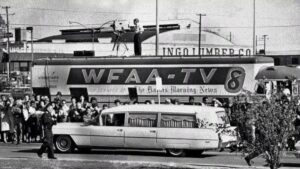
WFAA covering the hearse procession as it heads toward Love Field
And as luck had it, he happened to be on his way to lunch and ran into Jay Watson (WFAA Program Director) and Jerry Haynes in the lobby. Jay said, “I need studio quickly and camera live, whatever you can do.” And Turner said, “Well, what’s the big deal?” Jay said “The President’s just been shot.” And Turner, thinking he was getting his leg pulled said, “Okay, I’ll see you after lunch.”
So he hightails for his office, and hears the phone ring with me on other end. “Mr. Turner, it’s Bud, they let us out class today. Do you need any help?” He said, “How fast can you get here?” I said, “Ten minutes.” He said, “Come and find me and if you can’t find me, find Don Reynolds.”
And then it was absolutely crazy. I was running from studio to studio. Don said, “Strike all the studios if you can.” Everything was on wheels, so it wasn’t really that hard. One man could pull a set in or out. And, so, I struck Studio C which was set up for the Julie Benell Show. Her set had a music room, a kitchen and a patio room. Since everything was on wheels, when you put the sets back in a storage bin, the studio would be empty.
In Studio A they had it set up for Mr. Peppermint, the kiddie’s show. And that was a gigantic set. It took up almost the whole studio. So, I struck both those studios. And then Mr. Turner said, “Just stand by because we’ll probably put you on camera pretty soon.”
Paul: Had you run camera?
Bud: Not that much. So, I took a camera into Studio A, and I practiced. And that’s the key, practice, practice, practice. And then Don said, “Oh, can you put up an interview set because there might be some people coming in that we tape in another studio – while we’re on the air live.” So, I built a set, pulled things out from the storage area, and had an interview set ready to go. So, it was like that the whole day.
Back at Studio C was Julie Benell’s cooking show. Helen Haycraft who was Julie Benell’s assistant asked for help, “Don, can Bud help me here?” And Don said, “Sure, go ahead. Go with Helen.” So, we went back to the pantry. They had this gigantic pantry for the food show. And she started pulling things off the shelves that would make a stew. Helen defrosted some of the meat that they had back in the deep freeze.
Paul: So Helen started cooking for the crew and news departments so you wouldn’t have to leave?
Bud: Yes, thank goodness. Some of us stayed straight through. Those who had no families like me stayed overnight. So that was the way it was, basically the second weekend after they put me on a regular schedule.
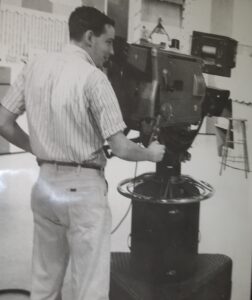
Bud on camera for Mr. Peppermint
Paul: So you basically jumped from being a gopher to a camera operator at this point. That was a quick jump.
Bud: Yes, and I think one of the first things that I shot was some kind of a proclamation, I just remember it being on my camera. And I looked up at the monitor and there it was, my camera shot on network TV.
Paul: That’s a good way to start the resume off.
Bud: Geez, I tell you! That was a crazy weekend. I did just about every job in the studio.
Paul: Bud, I remember hearing that Ted Cassidy, “’Lurch”’ from the Adams Family was the first reporter on the scene for the assassination.
Bud: Yes, I think so. He was on the our WFAA radio team.
Ted was a great guy, I really loved him. He was just one of these fantastic DJs at the time. I have a record there of Mr. Peppermint – the kiddie show – where he plays the part of Mister Echo or something like that because he had such a booming voice.
(Ted Cassidy comes on about the 43 and 51 minute marks)
Ted was a great guy, I really loved him. He was just one of these fantastic DJs at the time. I have a record there of Mr. Peppermint – the kiddie show – where he plays the part of Mister Echo or something like that because he had such a booming voice.
Jerry Haynes as Mr. Peppermint and Ted Cassidy as Mister Echo
Back then Don Norman did the afternoon movies. And if they had a sci-fi movie or a spooky movie, they’d dress Ted up because he was so tall and he’d come in and surprise Don or do a bit with Don. Paul, television, was so fun back in those days. Today it is just like an ironing machine.
Paul: Like Icky Twerp with those silly, goofy gorilla costumes. Today kids would boo them off the stage
Bud: Yes, indeed! And then Mr. Peppermint had all these little puppet characters. There were some great outtakes when Peppermint made a mistake. And Vern Dailey was the guy that did all the puppets, also the director of the show. But he’d get one of us to go up in the booth to direct if he had a little part to do on set like playing Muffin.
Paul: So let’s go back just a minute. You made it through the horrible days of the JFK assassination which was needless to say, your baptism under fire. Now as the dust settles, what happens next?
Bud: So fortunately for me, there was a guy on the crew who took a job at an advertising agency. So they needed someone and since I already filled in for this guy, all of a sudden I was there at the first of the year with a full-time job at Channel 8.
Paul: Right place, right time.
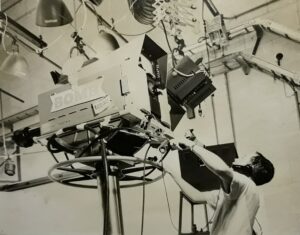
Tall camera, not so tall Bud
Bud: And that’s what I tell my UNT students. Volunteer. Stick your neck out. Ask what you can do. If I had not volunteered, I would have never had a job at WFAA.
And I was telling the story about a student that was in one of my classes and went to an ESPN remote. The announcer was having trouble putting his ESPN banner up, and he was the only person from ESPN. My student walked up and said, “Hey, can I give you a hand with that?” And he said, “Oh, man, sure.” So with his help, they put the sign up. My student sat and talked to him for a while, and he said “Hey, by the way, would you be interested in an internship over the summer at ESPN in Bristol?” And of course he said, “Yes.”
So, he went up to Bristol and had hopes of being a full-timer. But that didn’t happen and so he came back to school. Then on the last day of class, he got a call, and it was ESPN saying, “We have an opening. Do you want it?” And you could hear him shouting with joy across campus. Just for a student to get a job like that is fantastic. It all happened because he volunteered!
And, by the way, I don’t think I mentioned it before, but I taught at the University of North Texas for 46 years.
Paul: No kidding.
Bud: I was an adjunct professor. I’ve had so many students who’ve gone on to do bigger and better things. Originally I started out teaching television directing. And eventually they changed that course to television production so that it included directing and studio work.
One day I got a call from UNT, “Well, you wanna teach another class? Bill Mercer is retiring”. And I started teaching Radio/TV announcing. I did that for a good while. The first of the semester I taught the new directors the proper way to direct a show. There were kids coming in there with their scripts marked with fountain pens. And I said, “No, no, no, guys – Sharpie – Sharpie – you need to mark the script so that you see exactly where you’re gonna go and what you’re gonna do next.”
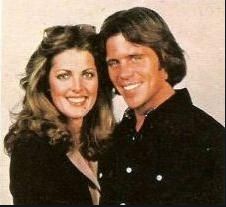
One of many folks to use Sump’n Else as a springboard. Joan Prather as Janet, Grant Goodeve’s wife on ‘Eight is Enough’
Paul: Let’s shelf that for a bit, and talk ‘Bud, the early years’, but we will most certainly get back to it.
Tell me about those early years including how you started work on “‘Sump’n Else”’.
Bud: This opportunity came in 1965 when Channel 8 decided to build a studio out at this new shopping mall way out in the country. They had built it across from the Caruth’s property – folks were saying they were crazy to
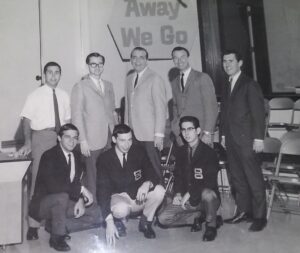
The Away We Go production team. Top left to right: Mort Salowitz, Jim Rowley, Ron Chapman, Ray Plagens and Bobby Brock First row: Ed Gepp, Bud Buschardt and Bob Cardenas
build a mall that far out of town. Of course that was NorthPark. WFAA built their studio right as you went in the main door.
What was so cool was that Ron Chapman had been a DJ, and all of us on the crew liked rock and roll so we learned how to do music programming from Ron. After a while he had so much to do that he let us program all the music that was on the show.
And if we had guests or if we had met people who were in a band that were pretty cool or we had interviewed or gone out and auditioned a band, we’d tell Ron, and he’d say, “Okay, if it’s good for you guys, bring them on in.” And so we got to audition a lot of the local talent that we used on “Sump’n Else”
In the morning, we had this dog of a show called “’Away We Go”’, oh, it was a turkey, but it was an excuse to work out the kinks in the studio.
Paul: Oh, what was the concept of “’Away We Go”’?
Bud: Well, it was a show for women and shoppers at NorthPark. They’d come into the studio, and we’d send some of them out on a wild goose chase. The show was kinda a cross between a snipe hunt and a scavenger hunt where the contestants would go look for items in different stores. Now, at Woolworth’s, you’ll find this or over at Cullum and Boren you’ll find that.
Paul: Of course, NorthPark was all behind it because it showed all the stores and everything in the mall.
Bud: Exactly.
Paul: So about this time you’ve graduated to Unit Manager of the NorthPark studio and our favorite show “Sump’n Else”. Tell me about some of the groups you had on
Bud: The Five Americans were really big there. And we introduced a group called the 13th Floor Elevators out of Austin. They were our house band for I think either two or three weeks at one time. They were a crazy bunch and so much fun.
The Five Americans on “Sump’n Else” courtesy Mike Rabon
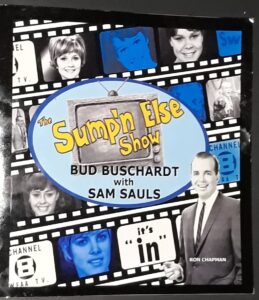
When someone tells you, ‘he wrote the book’, well…Bud did just that. Click on this photo to grab a copy from Amazon
If anyone had a hit record and they were in town, we would always get them on the show. Some of the other regular groups were Kenny and the Kasuals, The Briks, Mouse and the Traps and so many more that are listed in my book “The Sump’n Else Show”.
Paul: Did you ever have Kirby St. Romain on there?
Bud: Oh, yes, he was with Scotty McKay back then. I recently met the drummer for Scotty McKay. I take a rehab class at the Y and his wife was in the class. I went over to their house and I reconnected with Roger Guckenheimer who went by Roger Bland in those days. Scotty would hang out at the studio a lot because he had known Ron from the days at KLIF when Ron was a DJ doing record hops. If Scotty had a band, he’d bring them in and Ron would have them play live. Those were the most fun days of my life as far as working in television.
Paul: Doing “Sump’n Else”.
Bud: Yep, doing “Sump’n Else”. Jim Rowley was the director, Bob Cardenas and Ed Gepp were the cameramen.
Paul: So things are rolling along at “Sump’n Else”. Life is good. You got all these really cool bands coming through. Now things are happening for you. But you have to move on at some point. What was your “Sump’n Else” swan song?
Bud: Oh, that was kinda sad, but it was part of the business and how I got ahead. One of the directors had left Channel 8, and I was in line for the next directorship. So, I left the show in the summer of 1966. I’d still go over to the “Sump’n Else” studio on my days off. I did the news on the weekend and church services. That was how they broke in a director. You got to do church services and then the weekend news.
And we went to a different church every four weeks A Baptist one week, a Presbyterian the next week, Methodist, etc.
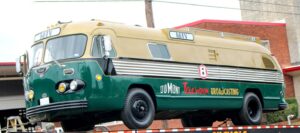
The Dumont Telecruiser after a lot of refurbishing by Chuck Conrad and the Texas Broadcast Museum https://texasbroadcastmuseum.com/
And it’s really funny because the van that we did all the directing out of was an old Dumont van. Chuck Conrad tracked it down and found it a few years ago. It was in horrible condition. Someone had pulled out a lot of the old television stuff and it was sitting there rusting.
He bought it for hardly anything, and now he’s fixed it up, and it’s beautiful. He has it at the Texas Broadcast Museum.
BTW – I saw you mentioned Chili’s in one of your interviews. I was there the night it opened.
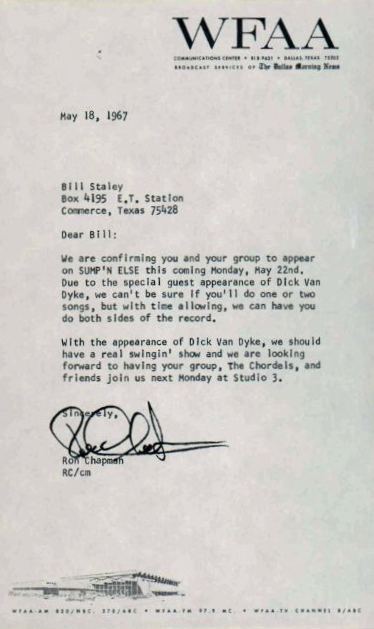
Letter to the Chordells from Ron Chapman to confirm their appearance. The rumor is van Dyke turned up feeling no pain. By the end of a very slurred segment, Chapman is screaming for the producers to bring the Chordells back on for a second number.
Paul: Of course, that was Larry Lavine’s place. I interviewed him for the Louanns’s article.
Bud: Larry told me one day “Let’s go record hunting. Take me record hunting!.”
So, I’d introduced him to the record wholesale house bars. And we went out and programmed the first jukebox that was in the original Chili’s on Greenville at Meadow.
Paul: Love it!

Don Henley’s band ‘Felicity’ in front of Honest Joe’s Pawn Shop
Bud: I remember some years later, long after Sump’n Else had left the airways, Ron Chapman had a recording session where he was doing an announcing job. And somebody said, “Ron, there’s somebody in the studio here who’s finishing a session and he wants to see you.” And Ron said, “Oh, okay, I’ll finish this first.” And when he finished, turns out it was Don Henley.
Paul: Oh my gosh!
Bud: And he said, “If I had known that, I would have finished a little bit earlier.” And they started talking and he said he had the best time. Don said ‘You know we used to appear on “Sump’n Else”? Ron said, “What was the name of your group?” And he said, “Well, I’ll tell you. We liked being on TV so much that we would change people and change the name of our group so that we could keep getting on your show as a new group.” So, that’s how Henley’s band Felicity got on the show
Paul: Jerry Smith was with Kenny and the Kasuals back in the day. He and a few other folks were telling me about their Don Henley days. They would all show up at the Studio Club during the day to try new material or check out a new band member or simply just goof off. Larry would tell them, “Yeah, you can go on and practice during the day. No problem at all.” They’d show up, turn the volume up all the way and see who could blow out the speakers.
Bud: That’s really funny because at lunchtime back when we were doing “Sump’n Else” show, we would go and watch Jimmie Vaughan practice. I remember Cardy telling me at the time “This guy is going to be big someday.”
He was just practicing alone by himself at a club when we went over there to see him one day. Yeah, so, it was like, you never know.
Scotty McKay wrote “Here Comes Batman” in the control room at “Sump’n Else”. He heard promos running about the show on ABC Television. And I said, “Oh, here. They just happened to send us a copy of the theme song.”
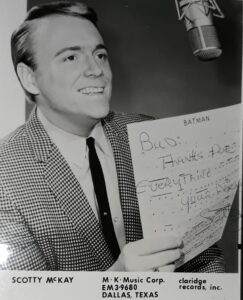
Scotty McKay thanking Bud
He said, “Let me hear it. Let me hear it.” He listened to it, and then he sat down, wrote all the lyrics to Batman, grabbed Kirby St Romain and then ran over to a recording studio and they got the group together and recorded “Here Comes Batman.”
I played on the show with The Jades from Ft Worth two times. We had a record out called Sha La La La Lee. Also once with John Fred and the Playboys when they had Judy in Disguise out around 1967. It was a lot of fun.
James Stennis of The Jades.
Paul: Isn’t that amazing?
Bud: Yeah.
Paul: You have some great memories there my friend.
Let’s get back to the “‘Bud Show”’ though. So, you leave “Sump’n Else”, go back to work running the church shows
Bud: Yes, it wasn’t too long after I left that they decided to end production on “Sump’n Else”.
So, they had a dinner for all of us – even I was included because that was the announcement that WFAA-TV wanted to become a news channel. And the consulting firm said, “You can’t lead into the newscast with a teenage show.” And we all said, “Wait a minute. This is crazy.”
We were in one television set per house back in those days.
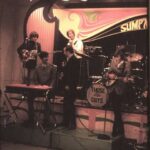
Ron Chapman with the group ‘Those Guys’ performing in the TV studio Summer 1967.
What teen viewers would do is turn on the “Sump’n Else” show, then the world news or something like that would come on right afterwards, maybe national news, I don’t remember who was on “Sump’n Else”. But, again, the television was sitting there, the mother would be cooking or fixing supper and the television would stay on that same channel.
Yeah, we tried to explain that to the consultants, but they just didn’t buy it. Channel 8 had hired them to do that.
Paul: Oh, I see.
Bud: The consultants came up with some really brilliant things like Channel 8 couldn’t decide what color to paint the new cruisers. And the consulting firm were told them to take the big remote truck. “Paint it white and put orange wheels on it. And here’s our $10,000.00 bill.”
But the consultants did not think that they teenage show would do well leading into a newscast.
Paul: Ha! Makes perfect sense.
Was that kinda at the end of “Sump’n Else” at that point?
Bud: Yeah, that was it, and that was all. It was over.
Paul: Wow.
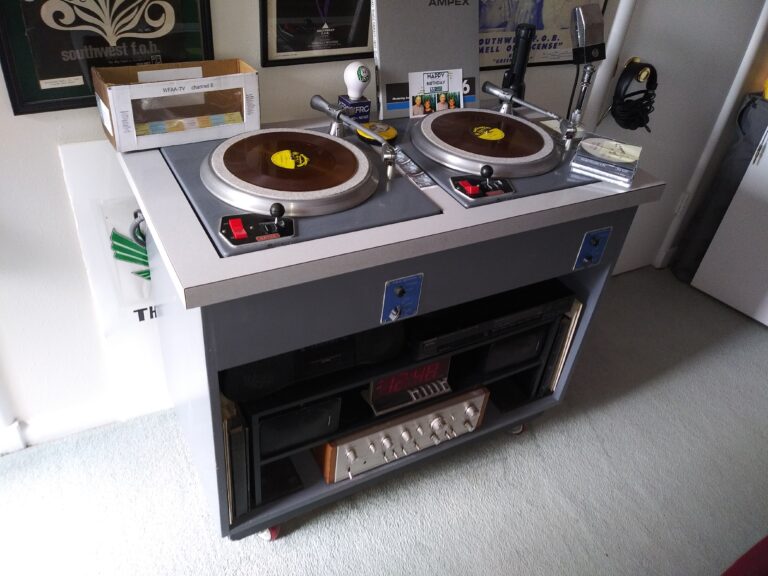
Bud snagged the turntables from Sump’n Else. And he is available for parties!
Bud: But to be fair. the station had places for everybody on the crew. In fact, what they were gonna do is – they saw that we were beginning to do a lot of production.
Now, visualize this. We were one of the only color video sorts of places. Channel 5 was color. We were color, but we were doing commercials. And, so, they decided they were gonna put together a production crew specifically for that.
Ron Chapman had this offer from KVIL. They were gonna change owners and he knew the new owner. He knew exactly what he was going to do and started work reprogramming KVIL in their big studio.
Paul: Okay, so let’s go back to Bud’s career. You had left “Sump’n Else” and you’re still at WFAA directing the church remotes.
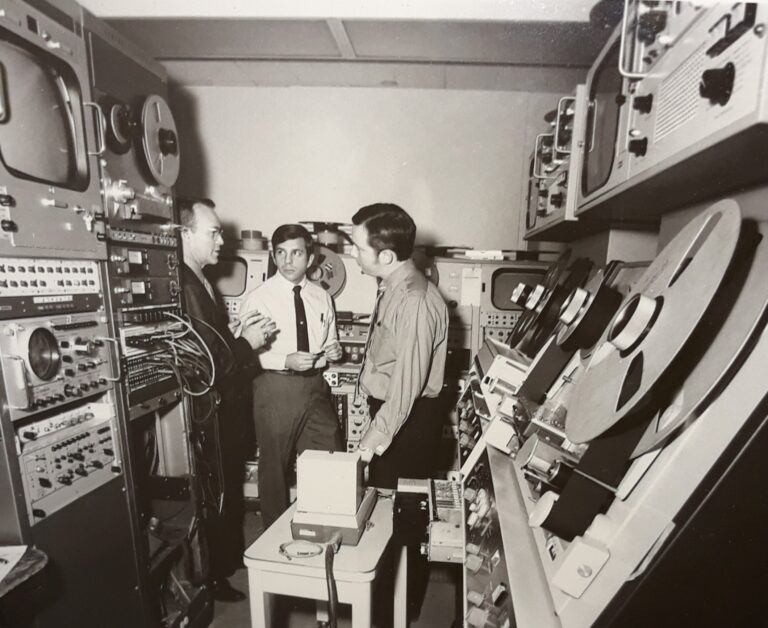
Bud in the backroom on WFAA. The amount of equipment it took to produce a show was incredible.
Bud: Well, the next thing was actually doing weekend news which was kind of a do-it-all because they had a short crew on weekends. And, so, I was directing the news. And that was back in the days when we didn’t have technical director. We didn’t have robotic cameras. We didn’t have any of the trash that we have today. But I would literally sit there with the news script by my side and turn the pages and run the switcher at the same time.
Paul: A switcher?
Bud: A video switcher, that’s how you punch the cameras between video sources.
Paul: Gotcha.
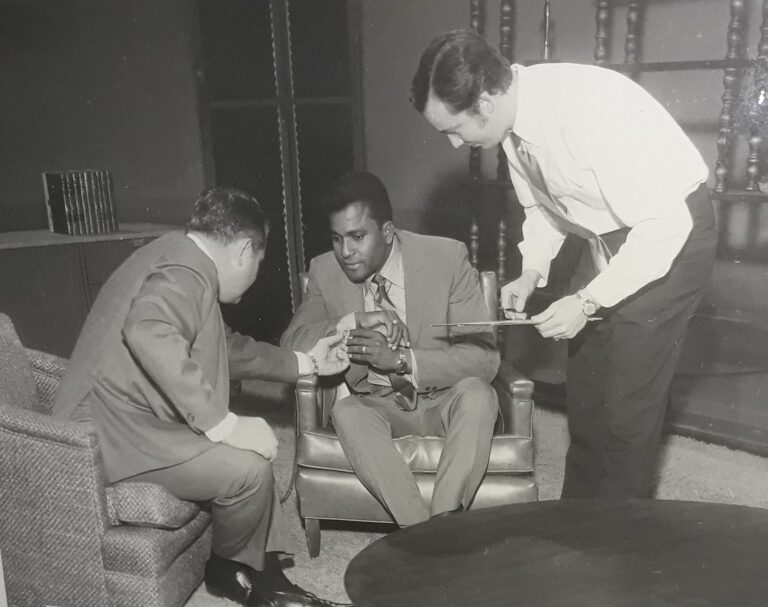
Legendary reporter Murphy Martin and Bud Buschardt interviewing the great Charlie Pride
Bud: I’m sitting there basically saying “and roll film” to myself.
Paul: Did they have teleprompter then?
Bud: Yes, we did, but they were very crude. The typewriters would type print in about an inch of type. And, so, you’d have to sit up there – And on these typewriters, you couldn’t go fast. It was click, click, click, click, click. So, it was a real pain to do teleprompter back in those days. So, we didn’t use them on newscasts.
Really not at all until the character generators came in to use.
Paul: You were the original one man show!
Bud: Indeed we were. Anyway, after doing the weekend gigs I started directing commercials. Jim Rowley was the commercial director. Tommy Johnson was producer. We had enough clients that we could spend time with a client preparing them for their next session. I shot 7-Eleven commercials for I guess about a year and a half, two years, something like that with Bob Stanford. There’s another great story for you.
Stanford was so creative and just wonderful to work with.
Paul: I knew him from my talent days doing commercials and training videos for Southland.
About what year would this be?
Bud: Seventies. It would be in the ‘70s.
And then Jim Rowley eventually came back from NorthPark and took over the 7-Eleven contract and they had me going out with salesmen. I had this talent of being able to sit down and talk to you if you were my client. ‘So, tell me, Paul. What about your business here? What are the selling points here?’
Paul: Sure.
Bud: What do you want me to know about Lacy’s Pipe and Tobacco? I didn’t smoke, but that was one of my clients. And he’d say, “Well, we have Thursday nights as family night and duh, duh-duh, duh-duh. So, the salesman would start talking to the client. I’d go off to another part of the building, take his words, and write a commercial and come back. And I’d say, “Well, how does this sound?” I did on-the-spot writing of commercials.
Paul: Wow. That’s some talent.
Bud: And that was back when we had little family companies other than a few biggies like Titche’s and Sanger’s, we did a lot of those commercials. But then we were interested in Lacy’s Pipe and Tobacco and Mama Joan’s two pizza parlors. What we were doing was developing clients who had probably been on radio but bringing them to TV. Benavides Mexican Restaurant comes by and he says, “Bud, I’m bringing you a whole bunch of food. Now, make this crap look good.”
Paul: Oh, man.
Bud: So, we would do something like put the dishes on a turntable and have the thing spinning around there.
I did that for a while, and then I just did several other jobs at Channel 8. And I’d been through just about every position that I ever really wanted to when – I decided to try something different.
There was a restaurant/club that opened up on Greenville called TGI Friday’s. They wanted to do oldies on the weekends, on Sundays. And they wanted to borrow the records from me. And Ron Chapman said, “No, I don’t think so. You need to hire Bud to be the DJ.” So, all of a sudden I am a DJ. at Fridays. And that’s how I got my start back into radio. I’d done radio in college, but I told myself, whatever job came first was what I was going to do. That’s where I was meant to be.
And isn’t it funny because there are so many radio people who wanted, actually who’d give you anything…“Oh, can you get me in a TV spot? I wanna be on camera.” And my career worked just the reverse. I started out in television and then ended up in radio. It’s really crazy, but that’s where it took me.
Radio was another accident. We had a new guy came in, Ira Lipson who was the program director for WFAA AM, and he converted it to music radio after a New York station. And that’s what we were in Dallas – music radio. And he also created KZEW-The ZOO. That was the first underground station that did anything in DFW.
Paul: Sure.
When artists were coming in for interviews on KZEW-FM or WFAA-AM, the deejays would always be hunting Bud around the building (no cell phones back then). He was our Music Man…respected for his VAST knowledge’.
Jan Gentile, former Playboy Bunny and KZEW personality
Bud: So, Ira was walking down the hall one day, and I joined him. He had been talking to me about doing an oldies show, but it never really turned into anything. Then Bobby Darin died. And I said, “Ira, would you like for me to go home and put together some bios and bring some records and give to your night DJ?” And he said, “Just a minute.” He went into the studio. And I was standing out in the hall wondering what the heck was going on. He came back out, and I said, “Well, what do you think? Do you want me to help Terry with the show?” And he said, “You and Terry are on at 9 tonight.”
So, there again was the volunteering that eventually led to my getting a radio show for a couple of years on music radio. And that was called 57 Nostalgia Place.
Paul: Wow.
Bud: And I really didn’t have that much experience in radio, but just being able to tell people about the artists and what they did along with what time frame they did it got me that gig.
But now in this day and time, if you capture a young audience like my students at North Texas I guess who were mostly in their 20’s, a tune will hit their ear and they’ll continue to listen to that. But if you tell them how old that record is, it turns them off.
Paul: Never really thought about that
Bud: That’s also what radio studies have shown that. And you don’t find a lot of oldie stations pinpointing the exact day anymore, at least in my circle of friends who do oldie shows across the country. But that’s another story. I was there for about three years before the format changed to News Talk. And then eventually it went back to oldies and then to news talk again. And then Belo sold the station. They wanted to get out of radio and sold the station, and that kind of wraps up my career at Channel 8.
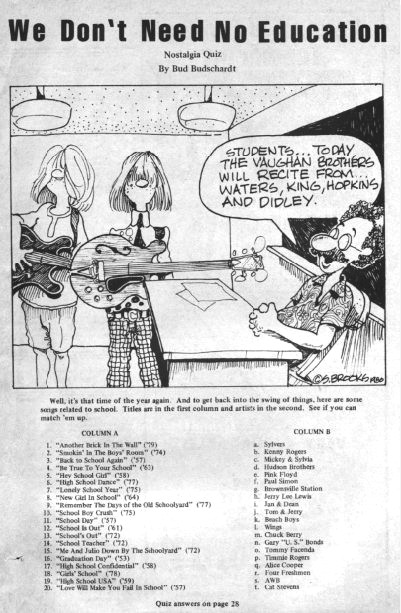
One of Bud’s sidegigs, stump the musician in Buddy Magazine. Courtesy of the artist Steve Brooks
Paul: What year would that be?
Bud: I guess that would be about 1981. And I’d done so many jobs there. My last job was producing commercials that ran on the air during drive time on about five or six radio stations. We would send feeds to different stations to hit the people in the cars on the way home. And I produced all of those – put the music, sounds, and everything together. And that was my last real job, and it was what I loved.
Paul: So, what’s the post-WFAA stage for you?
Bud: The next stage? Ron Chapman once again, he had been with KVIL for a while. He called me, “I just had a survey that our target audience of women want their oldies but goodies on weekends.” And he said, “I’m thinking about doing a show, would you be interested?” And, “Sure, when do I start?” And I started without even knowing the audio board. Steve Eberhart, was my cohort, my partner in crime and my audio board operator. Ron wanted me to learn the board and be able to carry it. And, so, I did the “Oldies But Goodies Weekend Show” for the next 10 years on KVIL.
Paul: Wow.
Bud knows so much about music it’s scary. His vast collection of 45’s? He can tell you what’s on the B side of every hit. That’s encyclopedic. I had never heard the difference between CD’s and vinyl, and thought he’d appreciate my purism about the latter. He proceed to load up the same track on both media, and seamlessly segued the same track from one to the other over the headphones he handed me. The second sample was the CD, and it felt like my head expanded. Great guy too. We met because of The Texas Music Association, and even worked a little on one of their showcases together. A Master of Musicology if ever there was.
Daryl Sprout – Performer, Speaker, Entertainer
Bud: About the same time, there was this Satellite Music Network that they had an idea that you could feed the signal up to the satellite and sell it to stations all over the country and customize it for each of those stations. So I’m on the air in Brownsville, on the air in Madisonville and all over the country without ever having to leave the studio.
Their system made it sound like I was in that city. That job was starting about the time that KVIL got the Dallas Cowboys contract. And when do they play most of their games? Sunday afternoons.
Paul: Nah, they didn’t!
Bud Buschardt is the radio and TV expert in Dallas-Fort Worth. I first met him at ABC Radio Networks around 1989, and he showed me his huge (200k+) record collection. I had never seen anyone with such an extensive record and tape collection, very impressive. Bud was born in Houston, and moved to Dallas after getting his Broadcasting degree at the U of H in 1963 to become part of the studio crew at WFAA-TV, which covered JFK’s assassination. He worked with local radio legend Ron Chapman as floor manager/assistant director for the “American Bandstand”-like local hit music show “Sump ‘N Else” from 1965 to 1968. Along with Samuel Sauls he authored the illustrated book “The Sump ‘N Else Show”, detailing Ron Chapman’s full career, and production highlights of the now legendary TV show. In 1972, Bud became an Adjunct Professor (now retired after 46+ years) at UNT, teaching various aspects of Television production. In radio, he was the first oldies DJ in North Texas, on WFAA-AM. He later produced the KVIL Oldies show, then ABC where I met him in 1989. He did the Night Train syndicated oldies show on the “Heart & Soul” format and later became Program Director of the “Stardust” super soft oldies format. In 2010 Bud was deservedly inducted into the Texas Radio Hall of Fame (he’s a chairman there now). Bud is DFW’s ultimate musicologist, a title richly earned!
-Jim Zippo, 98.7 KLUV Host and Personality
Part of Bud Buschardt’s fabulous audio collection, courtesy of his good friend Murphy Martin
Bud: Yep, they did. My show was at 10 till 2 on Sundays.
We could have probably created something like a tailgate party. But at the time, I quite literally lost my voice.
Paul: You mean your vocal chords?
Bud: Yeah, they were kinda frozen, really just totally paralyzed. I don’t know exactly what it was, but it was misery.
Fortunately, I got my voice back thanks to Dr. Kirkham, Carol Dearing was my voice coach. She said I had to start all over again, Paul, it was horrible
Paul: Oh I cannot imagine.
Bud: I started at Satellite Music Network and I did not have a voice. So I would produce the show. I was on three of their networks. I was on their black oldies network which was called “Heart & Soul”. And I did their early oldies we’d go back to the ‘40s, Louis Jordan and a lot of those guys who eventually were doing things that looked/sounded like rock and roll. And it was from the mid ‘40s till soul came in the mid ‘60s. We got into Aretha Franklin and James Brown
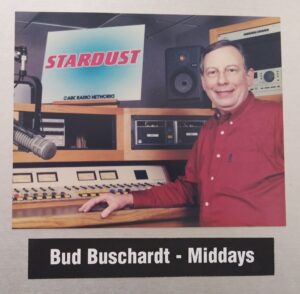
Bud in his midday slot at Stardust
Robert Hall who was vice president of the network heard my show on KVIL, and he said, “I want that on StarStation at night. Can you do that?” So the show I did locally on KVIL was the same one I used on their nationwide StarStation using basically the same script.
Paul: So, tell me about StarStation.
Bud: It was one of the five or six formats that Satellite Music Network offered their clients. We had Z Rock which was the underground loud hippie freak music stuff. And we had an oldies format. We had the black oldies format. We had jazz – smooth jazz types, contemporary hits of the day. I think there were about five or six. They had a country format. Then I eventually became program director for “Stardust”, we ran the gamut from big band all the way up through Neil Diamond.
Then there was a rumor that the Chicago office was going to go union.
So, John Tyler, president of the network immediately converted our production rooms into studios so that these guys could come down from Mokena to be in our building, for the ones who wanted to come to Dallas. And then eventually we were sold to ABC Radio. And we became ABC Radio in Dallas. Later we were owned by Disney. And we had about 10 formats including the Tom Joyner Show and Radio Disney. All of that was in our building over off Montfort. We were originating programming for all over the country.
We had a beautiful building there. It was really a nice place to work. It was really, really finished top-notch. And then about the time I retired in 2007, ABC wanted to get out of the radio except for ESPN and Radio Disney. Citadel bought them.
I was at ABC for 18 years.
Paul: So, you are tell me a bit more about your teaching career
Bud: And of course here’s where volunteering enters the picture again.
Dr. Ed Glick who was chairman of the RTVF department of what was then called North Texas State University. He would bring his classes for tours at Channel 8. And for some reason or another, I got to be the tour guide at Channel 8 in addition to my regular duties. And it was something I volunteered for because I love talking to kids
Paul: Sure.
Bud: I talked to Glick’s classes a couple of times. As I mentioned before, my mentor at the University of Houston was Dr. Tom Battin, his wife, was also a doctor. Every time that she would have a convention up here or something to do, Dr. Battin would come and stay with me and watch me direct and do show prep.
So, one day, I jumped into the control room. Dr. Battin was sitting there with me. And we did, “Floor check, camera check, camera one here, camera two here, camera three here.” And I heard “Bud, aren’t you gonna ask about your floor director?” And so I looked down there, and I said, “I know this voice.” He said, “It’s Ed Glick.” And I said, “Dr. Glick, what are you doing down here?” And he said, “Well, we came up for the summer, I wanted to learn what you guys were doing and what is contemporary so that I can take some of the ideas back to school.”
And I don’t know too many professors who would do that.
Paul: Yeah, the Professor is taking lessons from you.
Bud: Yep.
Dr. Battin was sitting next to me, “Is that Ed Glick? Dr. Ed Glick?” I said, “Yes.” He said, “Oh, we know each other from somewhere.” And it just so happened that I had a long lunch break. And, so, Dr. Battin, Ed Glick, and I went out to lunch at the Brass Rail – great restaurant. That was usually our Channel 8 hangout. We knew Malcolm the waiter and he knew exactly what we wanted. I can hear him now “You want chicken-fried steak today, don’t you?”
Anyway, so, we were at lunch, and Dr. Battin said, “So, Ed, when are you gonna hire this guy to teach a class?” And Ed said, “Well, I think I have something coming up in the spring.” And that was how my teaching career began.
Back then we had some pretty old black and white cameras, as this was a new thing for NTSU. They were trying to piece together equipment from stuff they had gotten from different television stations.
One of my students came up to me after announcing class one day, and he said, “My dad and I used to sit and watch Verne Lundquist together. We always watched everything that he did.”
Paul: Oh man, I loved that guy. What a delivery, just so smooth.
Bud: So this student said, “I would give anything to talk to Verne Lundquist.” So, I sent an email up to Verne, and Verne said, “Have him contact me at this number, and we’ll set up a time. So, they set it up, and the kid came back to class, and he said, “Man, I cannot believe that.” “Thank you so much,” he said. Verne had laryngitis that day, and he could only talk for a short time. But my student didn’t care, he said, “Bud, that was the best thing”
There are so many people in this business that you’ve run across who are egotistical, pompous – whatever, but then there are others in the business that are just great like Verne.
Paul: And now that you’ve brought that up, egotistical, pompous and others that are great – I’ve heard quite differing stories of Ron Chapman. Some paint him as a pompous jerk, then others saying ‘I loved that guy, he

Ron Chapman interviewing Sonny and Cher on “Sump’n Else”
taught me everything I know.”
Bud: And both could be correct depending on the situation. He certainly taught me a lot about radio and programming.
The great thing about “Sump’n Else” was that Ron had the experience in radio and programming, and also how to promote things. And while he was busy doing all of that, he left what records we played up to us.
Paul: Sure.
Bud: But at that time, he did not know television. He counted on us to make the show look good and kept him on cue and on time
Paul: Well, he must have done a great job because people are still glowing about that show from all these years later.
The way I remember him was what he contributed wherever we were. He would let you do your job if you knew what you were doing. He respected Rowley and Rowley’s directing, and the decisions that we made. Then he would add something like ‘Let’s put the go-go girls here today, and let’s put you down here’. That was Ron.
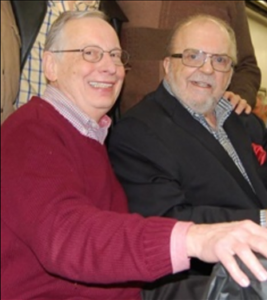
Bud and his good friend Ron Chapman
Once we learned how to pick the music to what the kids could dance to, we did that. But he was entirely different when I worked for him at KVIL. They would have meetings when somebody would get chewed out by Ron. As soon as Ron would leave for the day, everybody who was left standing had a great big group hug. His tongue could quickly turn into a razorblade but he did that in order to make us to work harder and become better.
But let me tell you this. In the control room, we had a light right above us – a red light that connected to the phone. And this is how serious Ron was. He listened to that station all the time. And one summer I was doing a show on summer songs and Beach Boys and all this kind of lighthearted music.
Paul: Sure.
Bud: And then the hotline rang. And it was like a light that they have on the meat to keep it hot at the store. That’s the way we kind of envisioned it. I thought, “Oh, my God. What have I done?”
Paul: God is calling.
Bud: Exactly, he was calling down from Heaven. It was Ron, and he said, “Hey, I just wanna tell you, man. This music is great. We’re sitting out here by the pool. And it – this is just working great.” “Thank you.”
Paul: And that’s all he wanted to tell you.
Bud: Yep. A call from The Man!
Paul: So, I heard Ron is not doing too well these days.
Bud: I talked to Jack Schell yesterday, and he said he’d been talking to Ron and that Steve Eberhart went out there about two months ago and had lunch with him. He said that Ron
looked better now than he has looked in a long time.
Paul: This has been fantastic Bud. What a great snapshot of Dallas history. I can see why your students love having you as their teacher and thanks so much for your time. I thank you and Memories of Dallas thanks you!

Bud at his current control booth which is strategically situated close to both the kitchen and the john
=====================================================================
You can add comments at the bottom of this page. For updates and our newsletter, be sure to add your email in this Newsletter Link
Come see us on Facebook at:
https://www.facebook.com/groups/MemoriesofDallas/
Our new sister page is dedicated to Football in the great state of Texas, from pee-wee to the pros. And Cheerleaders!
https://www.facebook.com/groups/texasfootball
Interviews, transcriptions, domains, webpages, SSL’s and so many other things to produce this interview, cost money. If you can donate a few dollars a month to help and keep these articles coming, Click Here! We are a fully approved 501c3 Non Profit. Let your CPA know you helped out!
All copyrighted materials included within Memories Incorporated dba Memories of Dallas are in accordance with Title 17 U.S.C. Section 107 related to Copyright and “Fair Use” for Non-Profit educational institutions, which permits Memories Incorporated to utilize copyrighted materials to further scholarship, education, and inform the public. Memories Incorporated makes every effort to conform to the principles of fair use and to comply with copyright law.
You can also share this story on your Facebook age or Twitter, click on the links below.
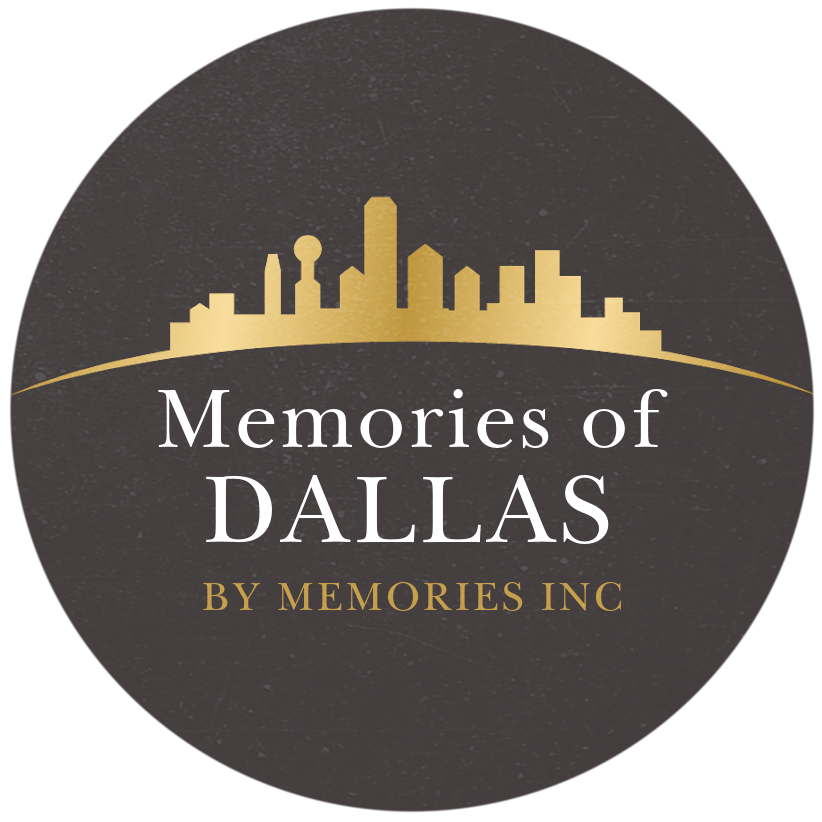
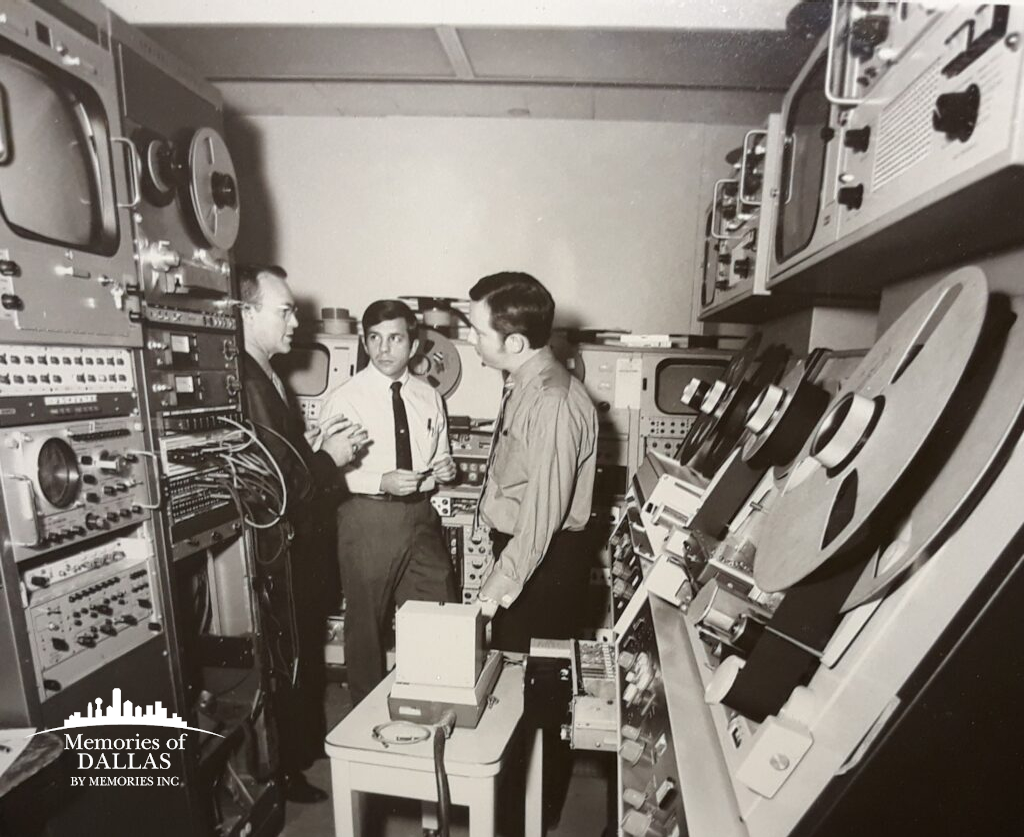


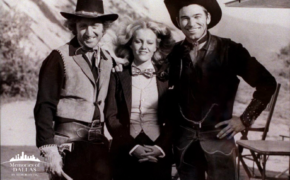
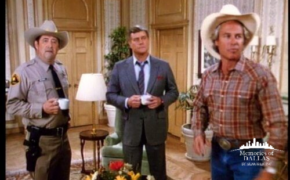
Ira Lipson
Great interview. Bud is known as one of the nicest guys in broadcasting and a human encyclopedia of music.
I was proud to give him his first radio show when I Was PD of WFAA am. Bud‘s Sunday show was number one 12 plus in DFW.
pheckmann
It was a lot of fun, thats for sure. Bud has done so much in his lifetime. His students adore him. And BTW, he spoke very highly of you Ira.
Esther McElfish
What an EXCELLENT interview….kudos to both Paul and Bud!??? Brought back many personal & professional memories of the days when the “broadcasting business” of Radio & TV was still a fun learning adventure, and not simply a line item on a corporate balance sheet! – So glad to learn more about Bud’s fascinating “evolution;” I lived out of state for a number of years and didn’t know about the transitions. Chapman’s career was interwoven with our TJ HS Classes, & I even taped a special message from him for one of our major Class Reunions!? THANKS to BOTH OF YOU for keeping all the memories alive for so many of us! ?❤
Happy Trails!?
Ed Hilscher
I enjoyed ;listening to Bud on his Sunday afternoon show on KVIL. His was better than anybody’s because he always had a core theme each week for the music. The beach, cars, summertime, or something else like that.
Thanks for the memories, Bud. You’re the best!!
John Rice
Paul – As a guy that grew up in Dallas with a transistor radio in the 60’s, I like to say how much I enjoyed your interview with Bud. Never having been in the business but hearing the likes of KLIF to KVIL and more , it was a pleasure to link Buds place in Dallas music history. Thanks
John Rice
meminc
thanks John. Bud and I spoke for nearly 3 hours. Maybe one day I can figure out how to put the whole thing up!
John Rice
Paul – As a guy that grew up in Dallas with a transistor radio in the 60’s, I like to say how much I enjoyed your interview with Bud. Never having been in the business but hearing the likes of KLIF to KVIL and more , it was a pleasure to link Buds place in Dallas music history. Thanks
John Rice